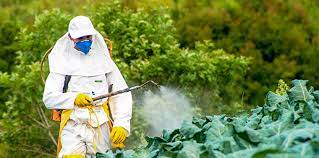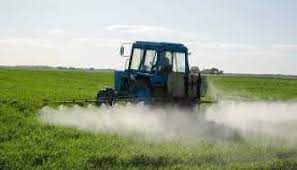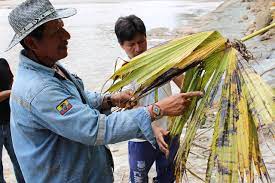Effects of Pesticide Abuse in Less Developed Countries (LDCs)
Pesticide use is estimated to result in 500 thousand cases of human poisoning every year. Approximately five thousand of these poisonings result in fatalities. Because pesticides are largely unregulated in LDCs and conditions for farm workers are grossly unsafe, the occurrence of human poisonings is thirteen times the number of poisonings in the U.S., and the percentage of deaths resulting from pesticide poisoning is greater than the worldwide average.
Moreover, statistics regarding injury and death from pesticides in LDCs underestimate the actual number of cases. Many pesticide-related illnesses go undetected or misdiagnosed because of inadequate medical resources, or because certain pesticide- related illnesses only develop many years after the initial pesticide poisoning.
Cases of Pesticide Abuse in Less Developed Countries (LDCs)
1. Documented threats of pesticide use in urban agriculture in Ghana.
It is estimated that, about 87% of Ghanaian farmers use chemicals to control insect pests and diseases on vegetables (Dinham, 2003). In a survey by farmers cited the presence of pests as a major indicator for pesticide application.
The excessive use of pesticides by farmers, who in most cases misuse the chemicals, has brought about many adverse effects of pesticide application. Literature is therefore replete with the deleterious effects of pesticide use in rural-urban agriculture in Ghana on both human health and the environment.
Ntowet al. (2006) in their study of farmer perceptions and pesticide use practices in vegetable production in Ghana found body weakness, headache and dizziness as the most frequently reported possible pesticide poisoning symptoms among farmers surveyed.
Studies conducted by Mensah et al. (2004) found that, in Akomadan and Afrancho, where farmers intensively use pesticides, about 56% of farmers had experienced sneezing , skin irritation (65.9%), headaches (48.2%), dizziness (40.0%), abdominal pains (20.0%) and cough (57.6%) after spraying.
About 30% of the farmers were also found to have low red blood cells while 38% had low white blood cells. Other health problems farmers face due to the improper handling and application and in most cases over-application of pesticide ranges from nausea/vomiting, blurred vision to death (including children) (Mensah etal., 2001).
2. Pesticide Misuse and Abuse in Nigeria
There is abundant evidence of poor pesticide education leading to extensive misuse in Nigeria (Asogwa and Dongo, 2009). For instance, cases of over-dosage, for one reason or the other, have been reported as common.
Even among government-trained, or agency-trained and assisted small-scale farmers, far more quantity of pesticides than prescribed is applied with the general expectation that it would affect more rapid killing of crop pests. Other unfortunate but common misuse of pesticides happening in Nigeria include:
Pouring pesticides (particularly old stock of Gammalin – Lindane) into rivers to kill fish which is then sold for human consumption.
Spraying Gamalin 20 on drying cocoa beans to prevent moulds and maggot development.
Mixing of different classes of pesticides (eg fungicides and insecticides) together so as to reduce the workload of spraying each differently. Apart from affecting effectiveness, such a practice could also dramatically worsen the potential health hazards.[Asogwa and Dongo 2009].
Wrong use of nozzles for spraying equipment, making it difficult for desired quantity of pesticides to be administered. Both over- dispensing and underdispensing could have significant adverseimpacts on the environment and on human health.
Lack of knowledge on the time needed for degradation of pesticides
Use of wrong formulations and doses, and wrong timing of application (all borne out partly due to inability to properly distinguish one pest from the other)
Counterfeiting, faking, and recycling of old stocks, manufacturing of empty plastic containers to market adulterated agrochemicals, which are sold at reduced prices.

Careless disposal of expired pesticides into the environment as regular waste, due to lack of proper disposal facilities or protocols.
3. Pesticide Abuse in Cameroun
According to the Food and Agricultural Organisation, 2004, in a report titled “pest control in cut flowers” many problems related to pesticide usage including environmental, air, water, soil and health.
A survey of pesticide application in Cameroon raises growing concern about various reports of illnesses associated with pesticide users.
In 1993, Mamatetal.expressed concern about the design of a lever- operated sprayer and listed specific features, which increase the risk of direct physical harm as well as the health hazards due to exposure to the pesticide sprays.
The following factors needed serious attention: leakages, design of the spray lance, tank weight, and sharp edges on the size of filler opening due to worn-out, sprayer tank, and narrow straps of unsuitable material.
During the preparation of the spray and also by holding the trigger valve on the lance, the hands are particularly exposed to the spray. The average use of pesticides by arable land is estimated at $10/ha.
Read Also : Factors Influencing Soil Moisture
Farmers also fight against diseases affecting crops by using multiple products indiscriminately to the extent without sufficiently being aware and trained on the correct choice of pesticides use. This is the case in Njombe where growers are particularly obliged to use pesticides to protect their crops.
This could eventually have an impact on health if they remain ignorant of its risk and adequate measures are not taken to prevent or limit contamination. Meijden, 1998, conducted a study on pesticide applications in cocoa farms and found out that “generally, farmers do not wear any protective materials at all, no matter what pesticide is being applied.
Farmers scarcely follow precautionary measures as they are found eating, smoking or drinking in-between spraying activities. The left over pesticides and empty containers are not properly disposed as the containers are sometimes washed and used for domestic purposes”.
4. Pesticide Poisoning and Associated Health Problem in SriLanka
Sri Lanka is one of the few developing countries where basic data are available and these show that the majority of poisoning cases are self- inflicted, by mainly young adults living in rural agricultural areas where agrochemicals are easily available. In several agricultural districts it precedes all other causes of death in government hospitals.
Studies in Mahaweli H: In Mahaweli System H a very high incidence of serious pesticide poisoning was observed with 68 percent due to intentional ingestion of liquid pesticides. It is argued that the easy availability and widespread use of highly hazardous pesticides is the most important reason for this high number of poisoning cases.
The frequent application of hazardous pesticides in high concentrations was often irrational and posed serious health and financial risks for the farmers.
Sales promotion activities and credit facilities promoted this excessive pesticide use, while not being counteracted by an agricultural extension service.
Hazardous practices when spraying pesticides were due to the impossibility of applying recommended protective measures under the local conditions, more than to lack of knowledge.
Studies in Uda Walawe: Although it is now well established that the majority of poisoning cases in Sri Lanka are suicide attempts, there is no consensus whether this is completely determined by social and cultural factors or whether it is mainly caused by the easy availability of hazardous agrochemicals.
Others say that the prevalence of mental illness is underestimated and accounts for many of the intentional poisoning cases.
So far there have been no studies that looked into the risk factors of acute pesticide poisoning and that have tried to establish the relative importance of the different determinants.
However, such information is essential to plan effective preventive and control strategies. In fact, it can be stated that the public health community has by and large ignored the subject, despite its importance in terms of morbidity and mortality.
5. Pesticide Abuse in India
Another case of indiscriminate pesticide dumping by a state owned department resulted in serious environment and economic revelations in the highly literate state of Kerala (Rajendran, 2002). Way back in the 1970s, the Plantation Corporation of Kerala (PCK) began aerial spraying of pesticides on its 2,200 ha cashew gardens in Padre Village in Kasargod district mainly to check pests during fleshing, flowering and fruit setting seasons.
Continuous and indiscriminate application of synthetic pesticides affected the flora and fauna, and local people became victims of severe health problems like cancer (Table 6). Records of disorders in Padre Village indicate that in each household at least one person has been found to toil and from 1990 to 2001, 156 cases of disorders from 123 households were noted.
In the beginning PCK sprayed endrin and later changed to endosulphan, an organochlorine, effective in a number of field crops. This pesticide has now been either banned or its use restricted in many parts of the world and for little economic gains for cashew production, the state itself contributes to damaging the environment.
Operation RanchHand
Agent Orange was a powerful herbicide used by U.S. military forces during the Vietnam War from 1961 to 1971, to eliminate forest cover and crops for North Vietnamese and Viet Cong troops. The U.S. program, codenamed Operation Ranch Hand, sprayed more than 20 million gallons of various herbicides over Vietnam, Cambodia and Laos from 1961 to 1971.
Agent Orange, which contained the deadly chemical dioxin, was the most commonly used herbicide. In all, American forces used more than 20 million gallons of herbicides in Vietnam, Laos and Cambodia during the years of Operation Ranch Hand. Herbicides were also sprayed from trucks and hand-sprayers around U.S. military bases.
It was later proven to cause serious health issues including cancer, birth defects, rashes and severe psychological and neurological problems among the Vietnamese people as well as among returning U.S. servicemen and their families.
Agent Orange The various herbicides used during Operation Ranch Hand were referred to by the colored marks on the 55-gallon drums in which the chemicals were shipped and stored. In addition to Agent Orange, the U.S. military used he
bicides named Agent Pink, Agent Green, Agent Purple, Agent White and Agent Blue.
Each of these manufactured by Monsanto, Dow Chemical and other companies had different chemical additives in varying strengths. Agent Orange was the most widely used herbicide in Vietnam, and the most potent. It was available in slightly different mixtures, sometimes referred to as Agent Orange I, Agent Orange II, Agent Orange III and “Super Orange.” More than 13 million gallons of Agent Orange was used in Vietnam, or almost two-thirds of the total amount of herbicides used during the entire Vietnam War.
Dioxin in Agent Orange In addition to Agent Orange’s active ingredients, which caused plants to “defoliate” or lose their leaves, Agent Orange contained significant amounts of 2,3,7,8- tetrachlorodibenzo-p-dioxin, often called TCDD, a type of dioxin.
Dioxin was not intentionally added to Agent Orange; rather, dioxin is a byproduct that’s produced during the manufacturing of herbicides. It was found in varying concentrations in all the different herbicides used in Vietnam.
Dioxins are also created from trash incineration; burning gas, oil and coal; cigarette smoking and in different manufacturing processes such as bleaching. The TCDD found in Agent Orange is the most dangerous of all dioxins.
Effects of Agent Orange:Because Agent Orange (and other Vietnam-era herbicides) contained dioxin in the form of TCDD, it had immediate and long-term effects. Dioxin is a highly persistent chemical compound that lasts for many years in the environment, particularly in soil, lake and river sediments and in the food chain.
Dioxin accumulates in fatty tissue in the bodies of fish, birds and other animals. Most human exposure is through foods such as meats, poultry, dairy products, eggs, shellfish and fish. Studies done on laboratory animals have proven that dioxin is highly toxic even in minute doses. It is universally known to be a carcinogen (a cancer-causing agent).
Short-term exposure to dioxin can cause darkening of the skin, liver problems and a severe acne-like skin disease called chloracne. Additionally, dioxin is linked to type 2 diabetes, immune system dysfunction, nerve disorders, muscular dysfunction, hormone disruption and heart disease.
Developing fetuses are particularly sensitive to dioxin, which is also linked to miscarriages, spina bifida and other problems with fetal brain and nervous system development.
Questions regarding Agent Orange arose in the United States after an increasing number of returning Vietnam veterans and their families began to report a range of afflictions, including rashes and other skin irritations, miscarriages, psychological symptoms, type 2 diabetes, birth defects in children and cancers such as Hodgkin’s disease, prostate cancer and leukemia.
Legacy of Agent Orange in Vietnam: The controversy over Agent Orange and its effects has persisted for more than four decades.
In addition to the massive environmental devastation of the U.S. defoliation program in Vietnam, that nation has reported that some 400,000 people were killed or maimed as a result of exposure to herbicides like Agent Orange.
In addition, Vietnam claims half a million children have been born with serious birth defects, while as many 2 million people are suffering from cancer or other illness caused by Agent Orange.
Factors for Aggravated Health Hazards from Pesticide Use
Some of the major factors leading to a preponderance of adverse health impacts associated with pesticide use in developing countries, despite relatively lower volume used compared with developed countries, include the following:
Highlytoxic pesticides are used:It is the most- deadly chemicals that are used here due to their being cheaper than newer safer pesticides (Erhunmwunseetal, 2012).
Poor legislation and Lack of Enforcement of Available Legislation: In Nigeria for instance, the regulations governing use of chemicals are encapsulated in the ECOWAS Regulations on Pesticides which covers all activities involving experiments on, as well as authorization, marketing, use and control of pesticides in the West Africa sub region; and the National Environmental (Hazardous Chemicals and Pesticides) Regulations, 2013 which deals with import, export, storage, usage, and marketing of hazardous chemicals and pesticides including other agrochemicals.
Read Also : Methods of Disposal of Waste Pesticide Containers
The NAFDAC regularly issues permits, valid for five years, for specific brands of pesticide formulations that can be used in the country. These laws are however weakly enforced.
Issues with Correct,Effective,and Safe Applications of Pesticides:Too frequently, people get unnecessary serious exposure to pesticides while applying them. This is due mostly to a combination of economic reasons and plain ignorance, many fail to put on required personal protective equipment such as gloves, overcoats, and masks [Asogwa and Dongo, 2009;
Lack of Adequate Information, Knowledge, and Awareness of theI nherent Dangers of Pesticides:There is low level of information, knowledge, and awareness among Nigerians, on the dangers associated with the use of pesticides.
Lack of Training on Correct Handling of Pesticides at Home:A major issue is the improper disposal of empty pesticide containers. Few people take time to thoroughly wash their hands with soap after the use of pesticides.
In a similar vein, some use domestic utensils for measuring and dispensing pesticides while several others store pesticides in family bedrooms and unlocked cabinets that can easily be accessed by children (Asogwa and Dongo, 2009).
Absence of Monitoring for Pesticide Residues on locally- consumed Products,
Inadequacies in Medical Recognition and Responses to Pesticide Poisoning
In conclusion, pesticides are among the most extensively used chemicals in the world today and they are also among the most hazardous compounds to human.
Despite the numerous benefits of pesticide in ensuring food security, indiscriminate use of pesticides may become unsafe and can cause both short term and long term damage to human and the environment.
Government attention should therefore be focused on the causes of indiscriminate use and abuse of pesticide, and appropriate action should be taken to reduce them.




